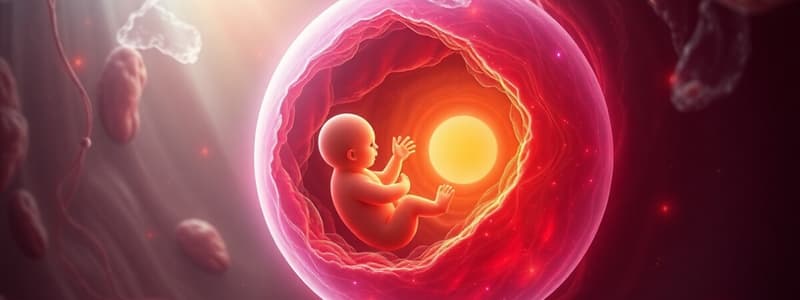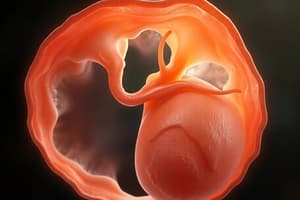Podcast
Questions and Answers
What is primarily developed from neural crest cells during early embryogenesis?
What is primarily developed from neural crest cells during early embryogenesis?
- Muscle tissues
- Brain and spinal cord
- Facial and cranial structures (correct)
- Limb structures
Which of the following developmental anomalies is an example of a clinical significance related to embryonic development?
Which of the following developmental anomalies is an example of a clinical significance related to embryonic development?
- Cleft lip and palate (correct)
- Down syndrome
- Spina bifida
- Congenital heart defects
What are pharyngeal arches primarily associated with in embryogenesis?
What are pharyngeal arches primarily associated with in embryogenesis?
- Formation of the respiratory system
- Development of the limbs
- Development of the face and neck (correct)
- Creation of the skeleton
During which stage of development does the formation of the palate occur?
During which stage of development does the formation of the palate occur?
What does the term 'alveolar bone' refer to in the context of embryogenesis?
What does the term 'alveolar bone' refer to in the context of embryogenesis?
What is one of the key influences on the changes in shape of the embryo during early development?
What is one of the key influences on the changes in shape of the embryo during early development?
What are the primary functions of the ectoderm layer during early embryogenesis?
What are the primary functions of the ectoderm layer during early embryogenesis?
Which layer of the embryonic disc is primarily responsible for developing supportive tissues such as muscles and blood?
Which layer of the embryonic disc is primarily responsible for developing supportive tissues such as muscles and blood?
During which weeks of embryogenesis is the development of the neuroectoderm initially observed?
During which weeks of embryogenesis is the development of the neuroectoderm initially observed?
What is the role of neural crest cells in early embryonic development?
What is the role of neural crest cells in early embryonic development?
What structure develops from the ectoderm during the early stages of embryogenesis?
What structure develops from the ectoderm during the early stages of embryogenesis?
Which embryonic layer is involved in the formation of digestive and respiratory organs?
Which embryonic layer is involved in the formation of digestive and respiratory organs?
What happens if there are interruptions during the development stages of neuroectoderm?
What happens if there are interruptions during the development stages of neuroectoderm?
What type of cells originate from the neural crest during embryogenesis?
What type of cells originate from the neural crest during embryogenesis?
Which statement about the embryonic layers is INCORRECT?
Which statement about the embryonic layers is INCORRECT?
What does the term 'bilaminar' refer to in the context of embryonic development?
What does the term 'bilaminar' refer to in the context of embryonic development?
What initially forms the primary palate during development?
What initially forms the primary palate during development?
During which weeks does the secondary palate develop?
During which weeks does the secondary palate develop?
What is the most common type of facial cleft in the UK?
What is the most common type of facial cleft in the UK?
What can significantly impact the treatment and diagnosis of cleft lip and palate?
What can significantly impact the treatment and diagnosis of cleft lip and palate?
What role does the tongue play in the development of the secondary palate?
What role does the tongue play in the development of the secondary palate?
What results in cleft lip?
What results in cleft lip?
Which structures are involved in forming the anterior 2/3 of the tongue?
Which structures are involved in forming the anterior 2/3 of the tongue?
Which of the following is NOT a potential factor in causing congenital anomalies like cleft lip and palate?
Which of the following is NOT a potential factor in causing congenital anomalies like cleft lip and palate?
What occurs when cellular apoptosis in the tongue development is disrupted?
What occurs when cellular apoptosis in the tongue development is disrupted?
What is a common risk associated with patients who have cleft lip and palate?
What is a common risk associated with patients who have cleft lip and palate?
Which of the following structures forms between the secondary and primary palates?
Which of the following structures forms between the secondary and primary palates?
What is the result of improper ossification in the maxilla and mandible during the development of alveolar bone?
What is the result of improper ossification in the maxilla and mandible during the development of alveolar bone?
Which of the following represents a key phase in embryogenesis and development relevant to facial clefts?
Which of the following represents a key phase in embryogenesis and development relevant to facial clefts?
What aspect of cleft lip and palate management can mitigate oral disease risks?
What aspect of cleft lip and palate management can mitigate oral disease risks?
Which pharyngeal arches contribute to the development of the tongue?
Which pharyngeal arches contribute to the development of the tongue?
What does the term 'alveolar bone' specifically refer to?
What does the term 'alveolar bone' specifically refer to?
What clinical feature is associated with a cleft palate?
What clinical feature is associated with a cleft palate?
What kind of teams can initiate treatment for cleft lip and palate at a young age?
What kind of teams can initiate treatment for cleft lip and palate at a young age?
What is an outcome of the tongue's development if its cells do not undergo apoptosis?
What is an outcome of the tongue's development if its cells do not undergo apoptosis?
What is the primary reason for significant impacts on feeding in patients with cleft lip and palate?
What is the primary reason for significant impacts on feeding in patients with cleft lip and palate?
What are the three embryonic tissue layers that form the tri-laminar embryonic disc?
What are the three embryonic tissue layers that form the tri-laminar embryonic disc?
What is the main function of neural crest cells during embryogenesis?
What is the main function of neural crest cells during embryogenesis?
During which weeks does the embryogenesis primarily occur?
During which weeks does the embryogenesis primarily occur?
What is the earliest stage after fertilization that begins the cleavage process?
What is the earliest stage after fertilization that begins the cleavage process?
Which process directly follows the cleavage stage in embryonic development?
Which process directly follows the cleavage stage in embryonic development?
What is formed during the bilaminar embryonic disc stage?
What is formed during the bilaminar embryonic disc stage?
What is the final developmental stage of the fetus called?
What is the final developmental stage of the fetus called?
Which phase of embryogenesis is most associated with the development of the face and palate?
Which phase of embryogenesis is most associated with the development of the face and palate?
What is the structure of the blastocyst primarily composed of?
What is the structure of the blastocyst primarily composed of?
Study Notes
Embryogenesis
- The formation of tissues and organs during embryonic development
- Starts with the three tissue layers (ectoderm, mesoderm, and endoderm) of the tri-laminar embryonic disc, which give rise to all tissues in the human body.
- Key phases:
- Fertilization, cleavage, proliferation, migration, and differentiation
Early Embryogenesis: Weeks 1-4
- Week 1: Begins with fertilization and progresses through cleavage (cell division) and proliferation (cell growth).
- Zygote, morula, and blastocyst formation
- Week 2-3: The blastocyst develops into a bilaminar embryonic disc (ectoderm and endoderm) that later transforms into the trilaminar embryonic disc with the addition of the mesoderm.
- Week 3-4: Development of the neural tube and neural crest cells from the neuroectoderm.
- Neural crest cells play a crucial role in the development of the head, face, and oral cavity.
Development of the Face, Palate, Tongue, and Alveolar Bone
- Week 4-8: Development of key oral structures:
- Palate: The secondary palate forms from the palatine shelves, which grow from the maxillary prominence and fuse together with the primary palate and nasal septum.
- Tongue: Forms from the first, second, and fourth pharyngeal arches.
- Alveolar bone: The maxilla and mandible undergo ossification, starting in their respective prominences.
Clinical Significance
- Aeitiology of Developmental Anomalies: Developmental anomalies can be caused by genetic or environmental factors.
- Example: Cleft Lip and Palate: A common facial cleft resulting from failed fusion of the maxillary and nasal processes.
- Can impact feeding, speech, hearing, and development.
- Early diagnosis and treatment are crucial for reducing the impact on patients.
Video Recap
- Watch the video at [link] to visualize the detailed stages of face development and the intricate process of forming the various structures.
- Pay attention to the changing shapes of the embryo, the pharyngeal arches, and the prominences.
Learning Resources
- Utilize the provided workbook activities, oral embryology reading list, and online resources for further exploration and knowledge consolidation.
Studying That Suits You
Use AI to generate personalized quizzes and flashcards to suit your learning preferences.
Related Documents
Description
Explore the stages of embryogenesis, focusing on the formation of tissues and organs. This quiz covers key phases from fertilization through the development of the trilaminar embryonic disc and neural structures, as well as the early development of the face and oral cavity. Test your knowledge on the critical weeks of embryonic growth and differentiation.




